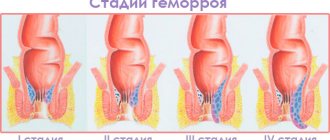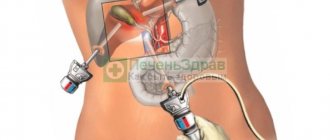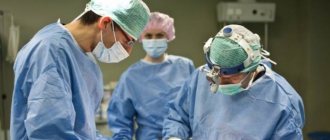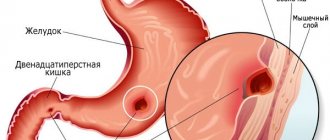Indications for surgery
Indications for surgical intervention are:
- haemorrhoids;
- fissures in the anus;
- bowel prolapse;
- infectious lesions (in particular, diverticulitis);
- tumor processes;
- cancer;
- Crohn's disease;
- necrosis, ulcers and erosion of fragments of the rectum, provoked by inflammation;
- ischemia of areas of the rectum due to thrombosis;
- damage due to injury.
The operation can be corrective. It is carried out after primary surgery to correct deficiencies.
Contraindications for rectal surgery
Before performing surgical treatment, it is necessary to exclude possible contraindications. Neglecting them can lead to the development of complications with possible death. Since the surgical intervention involves the removal of a section of the colon for health reasons, the list of contraindications is narrow. These include severe patient conditions, which are manifested by instability of vital functions.
These violations can occur when:
be careful
- Cachexia with loss of a significant amount of body weight.
- Anemia of the second or third degree.
- Failure of the cardiovascular, respiratory, and urinary or hepatic systems.
- Involvement of neighboring sections with tumor invasion and possible death.
Resection of the entire rectum is performed when the tumor has grown into other parts of the pelvis.
Types of rectal resection
Several methods are used to perform operations on the distal intestine. The choice of a specific rectal resection technique depends on the nature of the pathology.
Anterior resection. Using this technique, cancer tumors localized in the upper part of the distal tract are removed. Surgical access is organized by creating an incision in the lower abdomen. The doctor excises the S-shaped section and the part of the intestine connected to it. After removing the fragment, the ends of the organ are brought together by anastomosis.
Anterior abdominal resection of the lower type. The technique is used in cases where pathological processes affect the middle and lower part of the rectum. The doctor preserves the sphincter by completely excising the rectum, mesentery, and anus. Lower anterior abdominal resection is often used for cancer to remove the damaged area of the organ and the tissue connected to it (this eliminates the possibility of relapse). Surgical access is formed in the lower part of the peritoneum. After removing the pathological area, the intestine is connected to the anus using an anastomosis.
Extirpation of the rectal section of the abdominal-perineal type. The surgeon removes the rectum, anal canal and sphincter muscle ring. The operation requires the creation of two surgical approaches (an incision in the abdominal region and an incision in the perineal area). In the future, stool will be released through the colostomy.
Complete removal of the rectum (proctectomy). The method is used if the tumor is localized in the rectum, no further than 50 millimeters from the anus. To preserve bowel function, the doctor creates an artificial stoma.
Operations without removing the sphincter. The method involves the use of staplers. They allow excision of a fragment of an organ without affecting the function of defecation.
Transanal removal. Excision of the pathological area is carried out through anal access, using special instruments. The sphincter cannot be removed. The method is used if the affected area is localized in the lower lobe of the rectum. A two-stitch suture is placed on the incision. Such partial removal is relevant in cases with non-aggressive small tumors.
Repairing cracks. The technique allows you to correct the patient’s condition with hemorrhoids and recurrent/multiple anal fissures.
Bougienage. The technique is used in the formation of strictures. Using special instruments, the doctor expands the intestinal lumen through mechanical action.
Life with a colostomy
A living example of how people with a colostomy live.
Having a colostomy on the anterior abdominal wall leads to a change in lifestyle. The patient needs to know about several rules, as well as recommendations that will maintain quality of life and eliminate the development of complications. The basic rule concerns skin care around the stoma, as well as bags. Patients need to carry out hygienic cleaning and replace the bag after each emptying into the container or as the contents accumulate. In this case, it is worth excluding the long-term use of one colostomy bag.
It is recommended to change your lifestyle by eliminating foods that irritate the digestive system from your diet. Food intake should be small and fractional. Overeating and foods that cause fermentation or excessive gas formation should be avoided. Constipation with a colostomy requires the use of specialized means.
The selection of a colostomy bag should be carried out by the attending physician; he will help you choose the most appropriate size and adhesive material that will not cause tissue irritation. A colostomy near the rectum ensures that the skin does not get wet. It is important for patients to monitor the condition of the skin around the stoma opening. This area becomes sensitive to irritation, allergic reactions, as well as ulcers and bedsores. At the first suspicion of the development of the disease, it is important to seek help from a doctor.
The operation to remove an existing colostomy is carried out subject to complete recovery.
Preoperative preparation
Surgeries on the rectum require serious preparation from the patient. Before surgical procedures, the following examination is prescribed:
- general urine analysis;
- general blood test, group and rhesus tests;
- coagulogram;
- tests for HIV, syphilis and hepatitis;
- ECG;
- X-ray of the thoracic organs;
- MRI of the pelvic organs;
- biopsy of atypical tissue (for patients with cancer and suspected cancer).
The patient must visit a therapist, and women are additionally examined by a gynecologist.
A few days before surgery, the patient must switch to a special diet (no fiber). On the day before surgery, the patient is given an enema. You should not eat heavy or solid foods on the eve of the procedure. 8 hours before resection, no food or liquid is allowed.
ATTENTION! An alternative to cleansing enemas can be laxatives.
If the patient takes blood thinning medications, they will have to be stopped several days before the operation.
Preparation before surgery
As before any other operation, before removing a rectal tumor it is necessary to undergo a full and comprehensive examination. To do this you need:
- donate blood for clinical analysis, biochemistry, determination of group and Rh factor, coagulogram;
- urine for clinical analysis;
- examination of material for infectious diseases (HIV, hepatitis and syphilis);
- ECG and fluorography;
- Ultrasound examination of the abdominal organs;
- for women (required!) examination room;
- biopsy of the material taken;
- to more accurately determine the location - MRI of the abdominal organs.
Immediately 2-3 days before the operation you need to:
- adhere to a strict diet that excludes fiber content;
- start using antibacterial drugs that destroy pathogenic microorganisms living in the intestines;
- stop taking medications that thin the blood;
- 24 hours before surgery, try not to take solid food (preferably only drink). A cleansing enema is also performed or laxatives (Fitolax) are taken orally;
- 8-12 hours before surgery, avoid eating and drinking.
In situations where the patient's condition is unsatisfactory, surgical intervention is postponed until the patient's well-being normalizes. For this purpose, procedures for blood and plasma transfusions, administration of saline solutions, treatment of concomitant diseases and others can be carried out.
The operation itself is performed under general or spinal anesthesia, which takes at least 2-3 hours.
Carrying out the operation
Carrying out the rectal resection procedure is associated with a number of difficulties. The distal section of the organ is fixed in the small pelvis and communicates with the sacrum and coccyx. Close to the rectal tract are the organs of the genitourinary system, nerve trunks and blood vessels. Due to special circumstances, the operation lasts quite a long time (on average 3 hours).
The operation is performed under general anesthesia. General steps:
- Preparing the patient (disinfecting the work area, administering an anesthetic).
- Removal of the pathological area.
- Formation of a bowel movement (or creation of a stoma).
Positioning in a narrow space
The rectum lies deep in the pelvis and is fixed on all sides - to the lower parts of the spine (sacrum and coccyx), to the organs of the genitourinary system and to the side walls of the pelvis.
Removing the rectum is a technically very complex operation. It is performed correctly only in specialized departments and centers. Surgeons who rarely perform such operations risk not completely removing the tumor, as well as damaging organs and structures near the rectum, which can lead to the development of serious postoperative complications, for example, impaired urine flow, lack of sexual function, damage to large vessels and nerves .
In addition, many clinics and oncology centers still use the old method of performing the operation “blindly,” when the surgeon frees the rectum from the surrounding tissue by touch. Due to the lack of clear visibility during surgery and the use of this method of rectal isolation, tumor cells often remain in the patient’s body, which leads to the rapid development of relapse - recurrence of the disease. In addition, rough hand selection “blindly” leads to injury to nerves, lymphatic ducts, and blood vessels.
How this is solved at the Clinic of Coloproctology and Minimally Invasive Surgery:
- We perform such operations every day; our clinic has accumulated significant experience in various types of operations for all types and stages of rectal cancer
- the rectum is always freed from surrounding tissues only under visual control with careful preservation of all surrounding nerves, vessels and organs
- During open operations, special German-made retractors are used to achieve a good overview and perform all stages of the operation under visual control. All tumor cells are removed, nothing remains.
- laparoscopic operations are performed using HD video equipment, including 3D images, which provide excellent visibility even in the deepest places of the pelvis
Postoperative period
After the operation, the person is transferred to the intensive care unit for 2 days. The patient must undergo additional treatment to fully recover. The condition of the postoperative wound is monitored on an outpatient basis. If the intervention was extensive, the patient remains in the hospital for a longer period (2 days or more).
In the early postoperative period, the patient's intestines are washed with antiseptic solutions (through a medical tube). After resection and extirpation, the patient is given a probe to drain fluid.
For the first 3 days, nutrition enters the body through an IV, because... the intestines need time to recover and begin functioning.
After surgery, attacks of nausea and vomiting are possible. In this case, the doctor prescribes medications that relieve unpleasant symptoms. Problems with bowel and bladder emptying may occur.
To exclude thrombophlebitis, the patient is advised to use elastic underwear/bandages. The problem of overstrain of the abdominal muscles is solved with the help of a bandage.
Complications after surgery:
- bleeding;
- infection of the body;
- suppuration in the area of sutures (internal and external);
- damage to internal organs and nerve trunks;
- failure of anastomotic sutures;
- hernia formation;
- thromboembolism.
Abdominal pain is a temporary complication. In case of intense pain, the doctor prescribes painkillers to the patient.
On average, the postoperative diet lasts 1.5 months. It is based on the rejection of coarse fiber. Fatty and heavy foods are prohibited. You can include meat (steamed or boiled), bread made from wheat flour, broths, thermally processed vegetables, cereals, jelly, and dairy products into your diet.
The volume of fluid consumed must be reduced to 1500 ml per day. It is allowed to drink tea, herbal infusions and clean water without gas (mineral water).
ATTENTION! Colostomy patients should limit gas-causing foods to a minimum. This category includes legumes, nuts, soda, beer and raw vegetables.
Over time, when the intestinal rhythm improves, you can introduce prohibited foods into the diet, monitoring the body’s reaction. Patients are also advised to keep a food diary so that if the body reacts unexpectedly, the cause can be identified.
The need for careful preservation of nerves
Near the rectum there are nerves that ensure the functioning of all pelvic organs: in men, these are the bladder, prostate gland, seminal vesicles, and urinary canal. In women, the vagina, uterus, cervix and bladder. The rectum is located in a very narrow space of the small pelvis, surrounded by very important anatomical structures. Therefore, during removal of the rectum, there is a risk of damage to the surrounding vessels and nerves, which can lead to significant dysfunction of the genitourinary system after surgery.
How this is solved at the Clinic of Coloproctology and Minimally Invasive Surgery:
- We have developed and are actively using methods of nerve-sparing operations for all stages of rectal cancer
- During each operation, special high-tech surgical instruments are used to separate the nerves from the rectum, using ultrasound energy, which does not injure the nerve tissue and reduces the risk of bleeding to zero
Rehabilitation
Patients with a permanent colostomy endure the rehabilitation process more difficult than other patients with rectal pathologies. The therapist must warn the patient about the need to form a stoma. A person has the right to refuse intervention. Therefore, it is very important to mentally prepare the patient and his family, because with a colostomy you can lead a full life.
ATTENTION! The newest colostomy bags are “invisible”. They do not stand out under clothing and have a convenient fastening system. All odors remain inside the colostomy bag.
Rehabilitation involves teaching the patient how to care for the stoma. At this stage, he learns to use a colostomy bag and control the process of defecation.
After surgery, the patient has the right to government support: receiving free colostomy bags and plates for their fastening.
In the last decade, the incidence of diseases of the digestive system, in particular cancer, has increased significantly. Often, patients seek help or learn about their problem only at the stage when only radical surgery to remove an organ (often the rectum) can help. This entails serious changes in the functioning of the gastrointestinal tract, a person’s quality of life and, unfortunately, not for the better.
Restoration of the intestine after surgery (especially the formation of a bone fracture on the anterior abdominal wall) in the context of general rehabilitation of the body will give the patient the opportunity to increase the comfort and function of the lost organ.
Contraindications and complications
Due to the fact that surgery to remove rectal cancer is prescribed only according to indications, the only contraindication is the serious condition of the patient. But it often happens that a patient is taken to the hospital in serious condition, but preparation for surgery provides an opportunity to find some time for such patients.
Common complications after surgery include:
- bleeding of varying intensity;
- damage to nearby organs;
- ventral or postoperative hernia;
- seam divergence;
- ishuria;
- blood clot formation.
Many patients refuse surgery for psychological reasons. Most often, this is the risk of impossible control of the act of defecation or a permanent colostomy through the anterior abdominal wall.
Changes in the patient's life after intestinal surgery
Rectal cancer
Colorectal cancer is one of the most common cancers of the gastrointestinal tract. This pathology ranks 4th in the domestic structure of the incidence of malignant tumors in men (5.7%) and 2nd place in women (7.2%).
The decision on the format of the operation is made depending on the location of the tumor, the presence or absence of metastases, and associated complications. Palliative interventions are carried out (surgical excision of the affected tissue is aimed at alleviating the patient’s condition, does not involve eliminating the underlying problem), partial or complete removal of the intestine.
Surgery for rectal cancer often entails the formation of an unnatural anus - a colostomy. Such actions, although aimed at preserving the patient’s life, cause severe complications and disability. A poorly functioning bone fracture provokes severe complications (purulent-inflammatory process, hernia, adhesive disease, wound infection). Making the intestines work in a new mode is very difficult.
Timely diagnosis makes it possible to avoid radical surgery. Endoscopic methods for examining the organs of the digestive system, including the rectum, are very effective in this regard. Colon cleansing with Fortrans before colonoscopy guarantees a high-quality examination of the mucous membrane.
After excision of the affected tissue or tumor of the digestive system, the patient always feels unpleasant consequences, including due to the use of painkillers, anesthesia, antibacterial drugs (most often in the form of tablets):
- constipation, diarrhea;
- flatulence;
- exacerbation of chronic diseases, for example, gastritis, colitis;
- discomfort, pain.
A person needs to deal with postoperative complications, take measures to prevent them, and get used to changes in the functioning of his body (in particular, caring for a bone fracture on the abdominal wall after removal of the rectum requires a lot of effort). This depresses the patient’s emotional state and reduces the quality of recovery. Special techniques and medications make it possible to improve the functioning of the digestive system, improve the condition of the mucous membrane, improve the psychological mood after surgical interventions on the digestive organs, and create a scheme for proper patient care.
Classification - what is important to consider
When planning treatment, a classification is used based on the size of the tumor, the existing invasion of the intestinal wall and the degree of spread of malignant cells to other tissues and organs. Thus, in stage 2 rectal cancer, a tumor up to 5 cm in size extends beyond the boundaries of the intestinal wall; cancer cells can be detected in the nearest lymph nodes.
The degree of tumor aggressiveness is also important. Depending on the morphological structure of cells, highly differentiated, moderately and poorly differentiated tumors are distinguished. The most common rectal neoplasms are well-differentiated adenocarcinomas; they are characterized by slow growth; in contrast, poorly differentiated tumors have a more aggressive course and poor prognosis.
Ways to restore the body
The most important stage in intestinal restoration is the rehabilitation period, which involves special care for the patient. Its goal is not only to monitor his condition, but also to transform his usual lifestyle into one that is necessary to normalize the functioning of the digestive system. Necessary:
- establish peristalsis (wave-like contractions that ensure the passage of food) of the organ;
- restore the balance of enzymes, beneficial bacteria and microorganisms to prevent digestive disorders - dyspepsia, dysbacteriosis;
- support the functioning of the gastric mucosa;
- prevent the development of complications;
- make adjustments to your diet and exercise schedule;
- carry out regular and thorough care of the suture, colostomy after removal of the rectum.
Advice: an early transition to natural nutrition is not recommended, it worsens the recovery process and provokes the development of complications.
There are several methods for intestinal restoration after surgery. They are implemented comprehensively in the context of patient rehabilitation.
Medication
Taking special medications helps prevent the development of dangerous complications. To prevent functional intestinal failure from developing, doctors use early drug stimulation of organ peristalsis: anticholinesterase drugs, neuroleptics, ganglion blockers. To prevent intestinal obstruction, it is recommended to take tablets with phosphatidylcholine and creatine phosphate. But at the same time, they disrupt the already undermined balance of electrolytes, potassium in the blood, and microflora, which requires additional prescription of drugs with bifidobacteria.
Physical rehabilitation
The main goal is a tonic effect on the patient’s body, improving blood circulation, tone of tissues and abdominal muscles. Some exercises can and should be done already in the early phase of the postoperative period to force the organ to recover. Breathing control, voluntary changes in tension and relaxation of the abdominal muscles will make it possible to reduce intra-abdominal pressure, establish peristalsis, and prevent constipation and urinary retention. Excision of a rectal fistula is also accompanied by postoperative physical therapy to strengthen the pelvic floor, including the biofeedback method (exercises to regulate bowel movements).
Diet therapy
Half the success of recovery depends on proper nutrition
First of all, proper nutrition, rather than taking pills, will help reduce the number of complications and speed up the regeneration of mucosal tissues and normalize peristalsis. This occurs by compensating for vitamin, protein, and mineral deficiencies and normalizing metabolism.
In the first 3-4 days after intestinal surgery (for example, after excision of a tumor with part of the colon), the patient is fed parenterally, that is, without the participation of the esophagus, the necessary substances are administered intravenously. If the intestinal resection was extensive or a colostomy was applied, then food intake by absorption of its components by the gastric mucosa begins only after a few weeks, supplementing it with special medicinal mixtures and preparations.
Natural nutrition begins in parallel with therapeutic nutrition with diet No. 0, then a few days after its completion, table No. 1a, 1b, 1 is used, and after 5-6 weeks - No. 15. Food should be easily digestible and not interfere with the functioning of the stomach, pancreas, gallbladder, and liver.
Advice: You should be careful when consuming milk. Often this product negatively affects intestinal function after surgery, especially if there is enzyme deficiency. But sometimes fermented milk products do not create such an effect. It is important to discuss this nuance with your doctor when creating a diet. In terms of energy, this food can be successfully replaced with soy products.
Surgeries on the intestines have a complex technology, can be accompanied by severe complications, and require special care after the procedure and taking medications. To start the digestive system and minimize the chances of developing complications, it is important to implement the entire range of postoperative measures to rehabilitate the body.
The main treatment method for rectal cancer is surgery. In the fight against tumors, modern oncology combines several treatment methods. Sometimes, to control the disease, chemoradiotherapy may be prescribed before surgery. However, surgery to remove a malignant tumor is the most effective, albeit radical, method of treating this disease. Many patients are interested in the question of survival rate after surgery. How long do they live after rectal cancer surgery, and what should the recovery period be like to completely defeat the disease?
Before answering these questions, you need to know exactly what surgical methods are used in the treatment of rectal cancer, their features, as well as the rules of rehabilitation.
Nutrition after colorectal cancer removal
After radical surgery, many patients eat approximately the same foods as before surgery. However, some foods can cause discomfort and therefore should be included in the daily diet only 2-3 months after surgery.
Rectal cancer, nutrition after surgery without adhering to a special diet, can provoke the following disorders of the digestive system:
Diarrhea
Dyspeptic symptoms in the gastrointestinal tract after rectal cancer surgery occur due to reduced water absorption and the presence of low amounts of nutrients in the intestine. Since surgical methods for treating rectal oncology involve removing part of the intestinal system, while reducing the area of absorption of chemical elements, almost all operated patients experience diarrhea in the early periods of rehabilitation.
Foods that contribute to the development of postoperative diarrhea:
Spicy and fatty foods. Caffeinated drinks such as coffee, tea and carbonated soft drinks. Artificial sweeteners. Citrus fruits (oranges, grapefruits). Popcorn and nuts. Raw fruits and vegetables, except apples, are completely safe to eat. High fiber foods (bran, whole grains, prunes and prune juice). All prepared foods at high or low cooking temperature. Milk and other fermented milk products. Alcohol.
If diarrhea occurs, it is recommended to avoid foods that cause diarrhea and drink plenty of water to prevent dehydration. During this period, potassium is actively washed out of the body and to replenish its reserves it is necessary to consume the following foods: bananas, apricots, peaches, potatoes, melons, honeydew melon, asparagus, lentils, sweet potatoes and medicinal salt mineral waters.
Constipation
Factors contributing to constipation:
Intestinal obstruction. Tumors that press on nerve endings in the intestinal tract. Performing a colostomy. Some types of chemotherapy drugs.
Possible preventive measures:
Drink at least 6-8 glasses of liquid per day. Include high fiber foods, fresh fruits, vegetables and bread in your daily diet. Increase physical activity. It is possible to use mild laxatives. Stoma irritation
Some foods are difficult to digest or do not have time to break down before colostomy bags. And therefore they can produce an irritating effect on the walls of the stoma. Patients are not recommended to use:
Foods containing seeds such as raspberries, strawberries and tomatoes. Nuts, popcorn and coconuts. Vegetables and fruits with thick skin. Gases
Oncology of the rectum after surgery and in the postoperative period may be accompanied by excessive gas formation.
Products that promote the formation of gases:
Eggs. Peas and beans. Some vegetables (broccoli, Brussels sprouts, corn, cucumbers, green peppers, onions, turnips, squash). Melons. Prunes. Fish. Cheeses. Beer.
Also, cancer patients diagnosed with rectal cancer after surgery are not recommended to chew with their mouths open, talk while eating, drink through a straw, chew gum, or smoke.
Unpleasant odors
The occurrence of unpleasant odors in people with costoma is usually associated with the consumption of the following foods: onions, garlic, asparagus, cabbage, turnips, eggs.
Rectal cancer after surgery can occur with or without complications.
Types of surgery
Currently, doctors for rectal cancer prescribe 2 types of surgical treatment methods, which are divided into palliative and radical. The first are aimed at improving the well-being and quality of life of patients. Radical surgery to remove rectal cancer eliminates developing tumors and metastases. If we take into account the surgical technique of carrying out such an operation, then this method is quite complex in medicine.
The diseased organ is located in the very depths of the small pelvis and is attached to the sacrum. Near the rectum there are large blood vessels that supply blood to the ureters and legs. Nerves located near the rectum control the activity of the urinary and reproductive systems. To date, several methods of radical surgery have been developed:
This surgical intervention is prescribed when the tumor is localized in the upper rectum. The surgeon makes an incision in the lower abdomen and removes the junction of the sigmoid colon and rectum. As is known, during the operation the tumor and adjacent healthy tissue areas are also eliminated.
The operation is performed if there is a tumor in the middle and lower intestines. This method is called total mesorectumectomy and is considered in medicine the standard method for removing tumors in these parts of the rectum. During this surgical intervention, the doctor performs almost complete removal of the rectum.
- Abdominoperineal extirpation.
The operation begins with two incisions - in the abdomen and perineum. The method is aimed at removing the rectum, parts of the anal canal and surrounding tissues.
Local resection allows you to remove small tumors in the first stage of rectal cancer. To perform this, an endoscope is used - a medical instrument with a small camera. Such endoscopic microsurgery makes it possible to successfully combat tumors in the primary stages of the disease. In cases where the tumor is located near the anus, the endoscope may not be used by the surgeon. Surgeons remove the malignant tumor from the patient directly using surgical instruments that are inserted through the anus.
In modern medicine there are also new methods of surgical treatment of rectal cancer. They allow you to preserve the sphincter of the organ, so radical measures are rarely used in surgery. One such method is transanal excision.
The method is used to eliminate small tumors that are localized in the lower rectum. To perform the operation, special equipment and medical instruments are used. They allow you to eliminate small areas of the rectum and preserve surrounding tissue. This operation is performed without removing the lymph nodes.
A malignant tumor of the rectum can also be removed using open laparoscopy. With the laparoscopic method, the surgeon makes several small incisions in the abdominal cavity. A laparoscope with a camera, which is equipped with illumination, is inserted into the organ through one incision. Surgical instruments are inserted through the remaining incisions to remove the tumor. Laparoscopy differs from abdominal surgery in its rapid recovery period and surgical technique.
Immediately after surgery, many patients have a special stoma created to remove bowel movements. It is an artificial opening in the abdomen, to which a vessel is attached to collect feces. A stoma is made from an open section of the intestine. The hole can be temporary or left permanently. A temporary stoma is created by surgeons to help the rectum heal after rectal surgery. This kind of hole, created temporarily, is closed by surgeons after a few months. A permanent opening is only required if the tumor is located near the anus, that is, low enough in the rectum.
In cases where cancer affects organs located near the rectum, extensive operations are performed to remove the tumor - pelvic exenteration, which includes the mandatory removal of the bladder and even the genitals.
Sometimes a cancerous tumor can create an obstruction in the intestines, blocking the organ and causing vomiting and pain. In such a situation, stenting or surgery is used. With stenting, a colonoscope is inserted into the blocked area to hold the colon open. With the surgical method, the blocked area is removed by the surgeon, after which a temporary stoma is created.
Preparing for surgery to remove colorectal cancer
Surgery for rectal cancer requires mandatory preparation. The day before surgery, the intestines are completely cleansed of feces. These actions are necessary to ensure that the bacterial contents of the intestine do not enter the peritoneum during surgery and cause suppuration in the postoperative period. In severe cases, when an infection enters the abdominal cavity, a dangerous complication such as peritonitis can develop.
In preparation for radical surgery, your doctor may prescribe certain medications that help cleanse the intestines. You cannot refuse to accept these funds. It is important to strictly follow all medical recommendations before surgery - take the right amount of fluid, not eat food, etc.
Recovery after surgery
Rehabilitation in hospital
Surgery to remove cancer requires compliance with all medical recommendations during the recovery period. Surgery to remove rectal cancer improves the quality of life of sick people and increases the survival rate of the disease. Today, surgeons are focused on carrying out organ-preserving methods and strive to minimize various functional disorders of the body after surgery. Interintestinal anastomosis allows maintaining the continuity of the intestine and sphincter. In this case, the stoma is not exposed to the intestinal wall.
Recovery of the body begins in intensive care. Under the supervision of staff, the patient recovers from anesthesia. Medical control will help stop possible complications and prevent bleeding. On the second day after the operation, the doctor allows you to sit down. Under no circumstances should you refuse and continue to lie down.
After surgery, abdominal pain and discomfort are relieved by taking analgesics. All ailments must be reported to medical personnel. Taking medications will help alleviate the condition. The doctor may prescribe spinal or epidural anesthesia using injections. Painkillers can also be administered into the body through IVs. A special drainage can be placed in the area of the surgical wound, which is designed to drain excess fluid. A few days later he cleans up.
You can eat and drink on your own two to three days after surgery. Food must consist only of semi-liquid porridges and pureed soups. Food should not contain fat.
On the fifth day, the doctor allows movement. To heal the intestines, you need to wear a special bandage. Such a device is necessary to reduce the load on the abdominal muscles. The bandage also allows for uniform pressure in the abdominal cavity and promotes effective healing of postoperative sutures.
If there is an artificial opening (stoma), it will be swollen in the first days. However, after a few weeks the stoma decreases in size and shrinks. Typically, postoperative hospital stay does not take more than seven days. If the surgeon places clips or sutures on the surgical wound, they are removed after ten days.
Rehabilitation at home: important points
Surgery to remove colorectal cancer is a major surgical procedure. After discharge from the clinic, it is very important to focus your attention on avoiding stress on the digestive tract. You must adhere to a special diet. High-fiber foods, fresh vegetables and fruits, and large pieces of food are excluded from the daily diet. Under no circumstances should you eat various smoked and fried foods. The menu should consist of cereals, pureed soups and boiled vegetable dishes.
Many patients report significant changes in bowel function after rectal surgery. It will take a particularly long time for complete recovery to occur when performing a total mesorectumectomy. With such a complex operation, the intestines are restored only after several months. After surgery, diarrhea, an increased number of bowel movements, fecal incontinence, and bloating are possible. The functioning of the organ can also be affected by radiation therapy given before surgery.
Over time, disturbances in intestinal function disappear. Regular eating in small, frequent portions will help restore the functioning of the organ. It is also important to drink plenty of fluids daily. For quick healing, you need to eat protein foods - meat, fish, eggs. The overall diet should be well balanced.
If diarrhea occurs, you should eat foods low in fiber. Over time, the diet is completely restored, and foods that previously could have caused serious problems in the functioning of the organ are gradually introduced into the menu. If you maintain your previous diet, you should seek help from a nutritionist.
During the recovery period, it is important to carry out the necessary exercises that are aimed at strengthening the muscles of the rectum and sphincter. Performing special gymnastics will prevent the occurrence of stool incontinence and help improve sexual life and normal functioning of the organ.
Surgeries for colorectal cancer at Asaf HaRofeh Hospital
There are different techniques and types of operations that can be used for this disease. The choice of surgery is determined by factors such as the stage of the cancer, the location of the tumor, and your overall health.
After the operation, the tissues that are removed by the surgeon are sent to a pathologist for examination. He checks the edges of the surgical area for the presence of abnormal cells. If they are found, it is possible that the cancer was not completely removed. When abnormal cells are found, repeat surgery or radiotherapy may be suggested.
Local resection
For a small tumor at stage 1, the cancer can be removed using local resection. An endoscope is used, a long and flexible tube with a small camera at the end. The operation is called transanal endoscopic microsurgery.
If the tumor is located very low in the rectum, near the anus, the surgeon may not use an endoscope. The malignant tumor will be removed using surgical instruments inserted through the anus. This type of surgery is called transanal rectal resection.
Total mesorectumectomy
This is a commonly used surgery for colorectal cancer. The surgeon removes the part of the organ that contains the tumor, as well as sections of healthy tissue on either side. In addition, the fatty tissue (mesorectum) around the rectum, including the blood vessels and lymph nodes, is resected. Its removal reduces the risk of relapse.
Types of mesorectumectomy
There are several types of mesorectumectomy. The choice of surgery is influenced by the location of the tumor in the rectum, its size, and the distance of the tumor from the anus.
Anterior resection
This type of surgery is usually used when the cancer is located in the upper and middle part of the rectum (near the large intestine).
After the part of the intestine containing the tumor is removed, the surgeon repairs the connection by bringing the two ends together. Some patients have a temporary stoma (ileostomy) created after this. The operation to close it is performed after a few months.
Proctectomy with coloanal anastomosis
This surgery is performed when the cancer is located low in the rectum.
The surgeon removes the entire rectum, connecting the large intestine to the anus.
Sometimes doctors create a bag (reservoir) from the colon (coloplasty) instead of a straight one to store feces.
After a proctectomy, a temporary stoma (ileostomy) may be created to allow time for the intestines to heal.
The stoma is closed after a few months.
Abdominoperineal extirpation of the rectum
This type of surgery (BPEP) is performed when the tumor is located very low in the rectum, near the anus. To remove all the malignancy, the surgeon performs a resection of the rectum and anus. In this case, a stoma is required and created - a colostomy. One incision is made in the peritoneum, the other in the perineum, near the anus. Through the final incision, the surgeon removes the anus and surrounding tissue.
Open or laparoscopic surgery for rectal cancer
Colorectal surgery is performed using an abdominal or laparoscopic approach.
Abdominal surgery is performed through a large incision running approximately from the breastbone (breastbone) to the belly button. In some patients, the incision is made across rather than along the abdomen.
During laparoscopic surgery, the surgeon makes 4 or 5 small incisions in the peritoneal cavity. A laparoscope equipped with a light and a camera is inserted through one of them, and surgical instruments are inserted through the others to remove the tumor.
Recovery from laparoscopic surgery is generally faster compared to open surgery. The surgeon will tell the patient what type of surgery is appropriate in this case.
Stoma (colostomy/ileostomy)
After surgery to remove colorectal cancer, some patients have an ostomy created to remove bowel movements from the body. This is an artificial hole in the wall of the abdomen, to which a bag is attached to collect feces.
A stoma is created from an open part of the intestine. If it is done using the large intestine, then this operation is called colostomy, when - through the small intestine (ileum) - ileostomy.
This artificial hole is used for a certain period of time or can be permanent. This is temporary to allow the intestines to heal after rectal surgery. Colostomy can be loop or end. To create a loop, the surgeon pulls a small loop of intestine out through an incision in the abdomen. Then he makes a hole in the loop and sews it to the skin. A loop stoma is called a double-trunk stoma, since two branches are removed.
To create an end stoma, the surgeon removes one end of the intestine through an incision and sutures it to the skin. The hole is placed on the left side of the abdomen. Often this type of colostomy is permanent.
If the hole is created temporarily, a second operation will be required to close it several months later to reconnect the bowel, twelve weeks after the initial surgery.
When the tumor is located very low in the rectum, near the anus, a permanent stoma will most likely be required. The surgeon will give information for each specific case whether the stoma will be permanent or temporary.
Девочки встречаются с приятными джентльменами, лучшие шлюхи Новосибирск, для сладострастных встреч в уютной обстановке. Незамедлительно дерзайте новые просторы с азиаткой, темнокожей или дамой славянской национальности. Стильные лучшие шлюхи Новосибирск, страстные и желанные, они такие модельные и стройные, что у любого появится желание. Твои мечты и желания реализуются.










